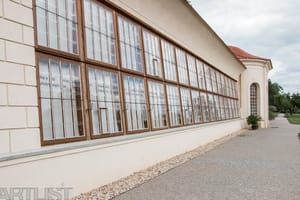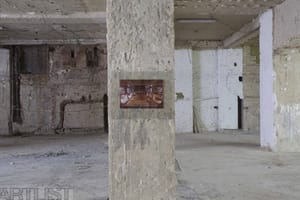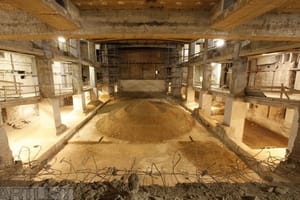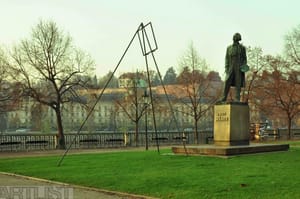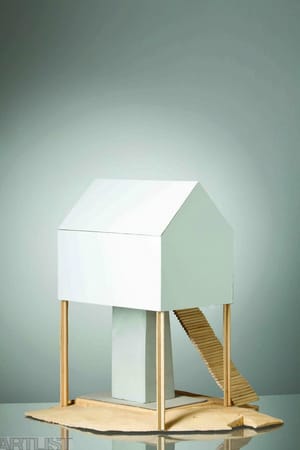- First Name
- Rudolf
- Surname
- Samohejl
- Born
- 1987
- Website
- http://www.rudolfsamohejl.cz/
- Keywords
- CSU Library
- ↳ Find in the catalogue
About artist
Rudolf Samohejl adopts a personal approach to sculptural tendencies that he is developing within a space created by an upcoming generation of artists that is increasingly part of the international scene and experimenting with new media and retro styles, the subjective appropriation of the aesthetic and formal trends of the global art world, and with the possibilities of transcending these trends. Samohejl’s work is characterised by a sensitivity to the multiplicity of contexts that intersect during the emergence of a work, and by a self-aware courage, somewhat puerile humour, and a generosity whose roots can be traced back to the minimalists and land-artists of the last century.
Rather than sculptures and installations, Samohejl creates “sculptural situations” in which the ideological and spatial location of a work plays a similar role to its perception or manipulation by the viewer. Though works such as Pile (2013) or 4’33” of Silence (2008) make formal reference to those monumental and geometrically stylised interventions in the landscape, no less important is their “story”, be this the performative dimension of the origin and end of the work, or its placement in the topography and historical contexts of a specific place, for instance an abandoned factory. The moment of temporality, the here and now within an endless range of possibilities, is highlighted in Forgotten Structures (2011) and Untitled (Stand for Josef Mánes)(2011–12). In the first case, abstract shapes of the simple metal constructions invade the roofs and rarely frequented public spaces, while in the second they form an amusing figurative memento. The view of the artist depicted with palette in hand is directed toward an easel whose contouring creates a space for the imagination and for forgetting.
Silence for Jirásek (2009–12) is unwittingly close to the work of the Japanese artist Tatzu Nishi, and has the artist proposing to enclose the monument to Alois Jirásek in a house on four wheels that the viewer would have to enter by stairs, so isolating the sculpture of the writer from the surrounding world and problematising the question of scale. Samohejl’s diploma work for the Sculpture Studio at the Academy of Arts, Architecture and Design in Prague (UMPRUM) is similarly situational. Passive Worker (Iambic Quatrain) (2014) is an aestheticised appropriation of public space that is based on the morphology of one of the non-places investigated by the artist, namely a site that has fallen through the net of the logic of urban planning or natural laws. The square object, reminiscent of a metal fence surrounding an excessively tight space, spent three weeks defying the weather and the effect of the human factor in a non-functional open space in the artist’s hometown of České Budějovice. It was then moved to an exhibition in Prague’s MeetFactory with a poetic anagram, namely turned inside out. The annexation of the gallery space opened up a game with scale and in the exhibition architecture the Passive Worker became an active, compelling agent.
Samohejl’s most recent projects shift the term “sculptural situation” still further and situate the viewer within multilayered realities. In Pure Potentiality (2015) the materials and work overalls became aestheticised items, structured elements and abstracted blowups or, on the contrary, miniatures. The motif of work appears once more, drawing the viewer into a rhythmic universe of coloured optical and material games rather than encouraging social speculation. In Strata Transformation (2015) the visitor to the gallery is taken to a seemingly relaxed space with hammocks and natural items strewn around the floor. However, the stratification of the individual elements of the installation complicate the initial inspiration, i.e. the transcription of a lecture by Robert Smithson. As in the case of other works, this is not so much about transcription per se (of text, gesture or form) so much as the variability of interpretation, the multiplicity of viewpoints, the disposition of the viewer’s body in respect of the components compiled by the artist, and the relationship between internal and external space. In general these are important points of reference in respect of Samohejl’s work on which he builds his consistent albeit open-ended methodology. His work encourages movement, shifts in interpretation and the exploration of trajectories between subject and possibility (more mental than physical) and the interaction between them.
- Author of the annotation
- Karina Kottová
- Published
- 2016
CV
2007–2014
Academy of Art Architecture and Design in Prague, Sculpture Department,
Dominik Lang and Edith Jeřábková, CZ
2012/13
Academy of Fine Arts in Prague, Studio of Guest Professor, Nicole Wermers, CZ
2012
Academy of Fine Arts in Prague, Studio of Guest Professor, Florian Pumhoesl, CZ
2011
Salzburg Summer Academy of Fine Arts, Peter Friedl, Austria
2010
Edinburgh Collage of Art, (Erasmus Exchange), Scotland
Residencies
2016
Ini Gallery, Prague, CZ2015–2016
Flow East Art Hub, Prague, CZ
2015
Space Called Place Organization, Krakow, Poland
2013
Egon Schiele Art Center, Český Krumlov, CZ
Awards / Nominations
2015
Jan Naaijkens Prize - Awardee, Tilburg, Holland
2013
Essl Art Award CEE - Finalist, Prague, CZ
2010
Josef Hlávka Travel Scholarship, CZ
Exhibitions
- Solo exhibitions
-
2016
Bower, Gallery konText, Curator : Adéla Procházková, Brno, CZ
2014 Paradigm of Place, V Jámě Gallery, Curator : Jakub Král, Ostrava, CZ
2013
Situation 40, Pavilon Gallery, Curator : Jan Pfeiffer, Prague, CZ
Fragment of Fundament of Palacky Monument, NIKA Gallery, Curator : Tereza Jindrová, Prague, CZ
2012
1/2, Buňka Gallery, (with Romana Drdová), Curator : Tereza Záchová, Ústí n. Labem, CZ
SILENCE! , Proluka Gallery, Curators : Krištof Kintera a Denisa Václavová, Prague, CZ
Like Water in the Basket, Jelení Gallery, Curator : Gabriela Kotíková, Prague, CZ
- Group exhibitions not included in ARTLIST.
-
2016
Place of the Monument, Vi Per Gallery, Curator : Anežka Bartlová, Prague, CZ
2015
Finding Neverland, Entrance Gallery, Curators : Tereza Jindrová, Rado Ištok, Prague, CZ
Oh, Block T, Curator : Philip Napier, Dublin, Ireland
2014
Journey, Meet Factory, Curator : Karina Pfeiffer Kottová, Prague, CZ
Art and Shadow, Czech Center Prague, Curators : Dominik Lang and Edith Jeřábková, Prague, CZ
2013
Problem is Here, Festival 4+4 Days in Motion, Prague, CZ
Lapidárium, Bethlehem Chapel, Curators : Studio of Sculpture AAAD, Prague, CZ
Jednotné vstupní parametry, Galerie 1, Curators : Jana Bernartová, Jan Kratochvíl, Prague, CZ
2012
Ř!, VŠUP Gallery, Prague, CZ
Early works, Sculpture studio AAAD (2009-2012), DOX, Prague, CZ
2011
AXA in Action, Hotel AXA, Prague, CZ
Stowage, Galerie in Alcatraz, Salzburg, Austria
2010
Feral Mind, Sculpture Court ECA, Edinburgh, Scotland
- Other realisations
Public Project
2016
Situation in Public Space « The Game Continues », Culture Night Tilburg, Holland
Situation in Public Space « The Game », Railway Station Bubny, Prague, CZ
Performance « 50 / 50 » with Cristina David, Museum Night, Meet Factory, Prague, CZ2015
Workshop « Who Cares », Literární Kavárna Měsíc ve Dne, České Budějovice, CZ2009
4‘33“ of Silence, Botanical garden Troja, Prague, CZ
Intersection of Ethnics, Brloh, CZ

